Camel Desert Trek – from Zagora to M’Hammid – Morocco
The Camel Desert Trek – the most expected days of my stay in Morocco. The Sahara Desert was always a challenge for camel caravans loaded with merchandise. Many routes studded the North of Africa to connect the main trading centers. Among them, Zagora stood in the Southeastern part of Morocco, at the end of the Draa Valley – a valley dotted with palm oases and fortified mudbrick villages (ksars). On the outskirts of Zagora, an old weather-beaten sign indicated you needed only 52 days to reach Timbuktu by camels. One of the trans-Saharan routes passed by the small town of Zagora (an important outpost for the trading caravans before they started to cross the endless, infinite desert).
Ever since I remember, I have been attracted by the desert life more than anything. I’ve read books, such as Wilfred Thesiger’s Arab Sands, and watched countless documentaries on National Geographic or BBC Travel. The desert has exerted an irresistible attraction on me, which I’ve always sought with impatience, curiosity, and genuine interest. I feel authentic when I ride on top of a camel hump through the desert.
In Morocco, I chose a pretty limited trekking circuit (only four days and 60 kilometers in total) but still a complex one. The route crossed the Southeastern mountains of Morocco (the Jbel Bani Mountains) and passed the highest and longest chain of dunes in the country (the Erg Chigaga Dunes, situated on the edge of the Sahara Desert).
The first day of the camel desert trek
Short Description. We loaded the camels with everything we needed in a deserted region between the towns of Zagora and Foun Zguid, then set off to cross the Faija Plateau and the Jbel Bani Mountains. From the Oum Laachar Pass, we descended along the Oued Lemhasser Valley to a well in the desert, where we camped overnight.
Long Description.
I could hardly wait. The camel expedition in the desert kept bugging me. The whole morning, I lay on the Berber sofas in the modest restaurant of Camping Oasis Palmier in Amzerou (a suburb of Zagora town). I pecked some bread with the customary Moroccan melted cheese and cleaned my still-sensitive stomach with a bit of mint tea.
My stomach hadn’t recovered yet after the food-poisoning with camel meat I had eaten in N’Kob two days before. I was somatizing within normal parameters even though I had added the excitement of embarking on a camel trek through the desert to my previous food-poisoning. Still, I would have had to pass through many unknowns. A Moroccan guide whom I had never met before, just the two of us in the wilderness of the desert. Excessive heat, reaching maybe 40 Celsius degrees during the day, in the middle of October. My not-so-good physical condition after ‘eating’ mainly water and mint tea for two days. BUT, I had a profound motivation to fulfill my dreams at all costs – traveling by camels in the Sahara Desert for several days. When you have a dream, you do everything you can, even if you’d crawl on all fours.
Mohamed called to tell me he was on his way to Zagora. He would pick me up from Amzerou around noon. I parked my car in the parking lot of the camping ground for several days. Then, I left together with Mohamed and an authentic Moroccan driver who was wearing a large blue turban wrapped around his head and a striped traditional djellaba. After a few hundred meters, we picked up Meriem – a Moroccan girl from Casablanca who had come to Zagora especially for this desert adventure. We went with a decrepit and dusty jeep on the road from Zagora to Foun Zguid and reached the starting point of the trail. I felt pressured by the heat and my continuous fainting-like state, so I insisted to Mohamed to buying more bottled water for drinking.
We turned left from the main asphalt road and drove a few hundred meters into an arid, deserted area of the National Park d’Iriqui. Two camels and their caregiver, Lahssen, were patiently waiting for us in the shade of a frail tree. It was part of the desert life ritual to wait for hours under a lonely tree. The only tree in that area. There was nothing else around us – just that tree, many rocks, and dry soil.
We downloaded all our luggage from the jeep and piled it up in the shade of the tree. We loaded the camels at maximum with food supplies for four days. Including tents, mats, gas tanks, a portable stove, and plenty of bottled water. All this stuff magically fitted within four big twig baskets, arranged on both sides of the camels’ humps. A large casserole with eggs was strategically tied up on top of everything. Eventually, we had late lunch on a mat under the acacia tree (roast chicken, fried potatoes, and coca-cola), then we set off for our journey. At first, we had to cross the vast Faija Plateau and climb up in the Jbel Bani Mountains.
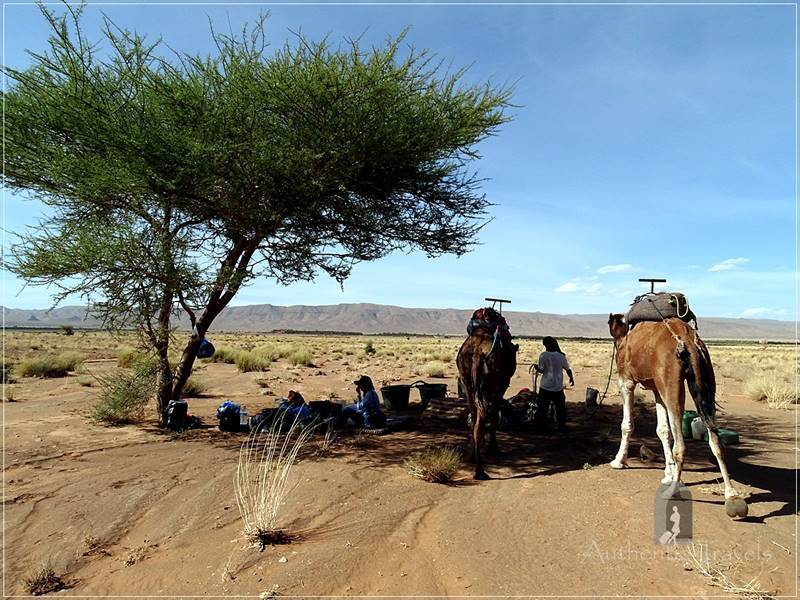
Camel Desert Trek – Day 1: lunch under the only tree in that area (fried chicken with potatoes and coca-cola)
The Faija Plateau lay at the foot of the Jbel Bani Mountains – small mountains with rocky terrain and arid scenery. We reached the foot of the mountains after half an hour of walk and then started to hike up. The footpath snaked between large, black boulders, hard to overtake. We hiked up for approximately one hour until we reached the Oum Laachar Pass. The heat was overwhelming and unbearable. At 40 Celsius degrees, warm water didn’t quench my thirst at all. Lahssen and the camels followed us but eventually, they overtook us. On long distances, camels walk faster than human beings even though they are super-loaded. They don’t need breaks to rest. The sun stood just above our heads. I was sweating as if I were under a shower. And I still felt something like a big lump in my stomach.
From the Oum Laachar Pass, we gently descended on the other side of the Jbel Bani Mountains, then rode the camels along the Oued Lemhasser Valley. I had to focus on riding on top of the camel, and this reconnected me to another world. My stomach problems disappeared right away. While we were immersing in its dimensionless immensity, I saw the desert spanning in front of me. We descended for half an hour to a well where we set up our camp at dusk.
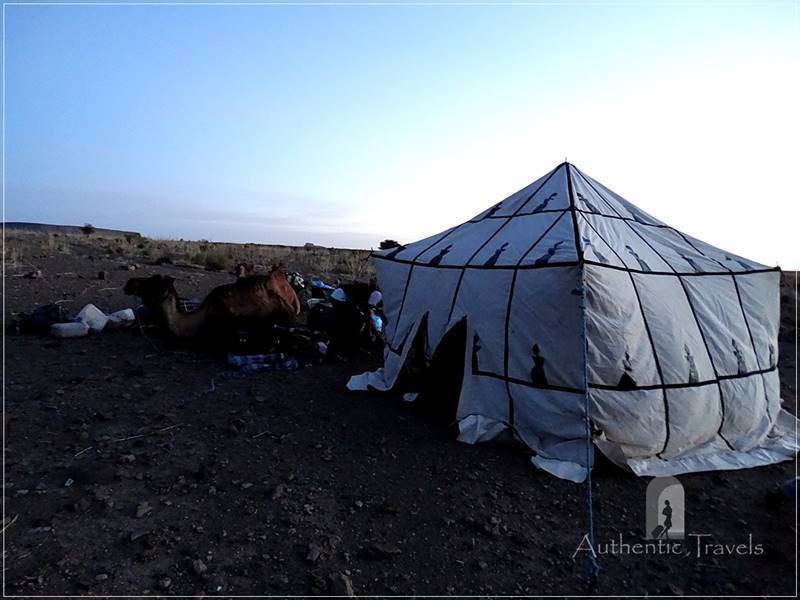
Camel Desert Trek – Day 1: Near the Tighrghrin Oasis – our camp for the first night (the kitchen-tent)
Lahssen and Mohamed gave water to the camels. Then they tied the camels’ feet and let them free to graze dried plants. After that, they pitched a large kitchen tent with Berber decorations and started to cook on a gas stove. I pitched my small tent nearby, without anchoring it. Meriem helped me to take out water from the nearby well with a pulley and a leather bag. In the evening, we all gathered inside the big tent and drank Moroccan mint tea. Then, we had a traditional tajine cooked with delicious lamb meat preserved in brine. A strong wind blew with power during the night and I had to wake up and anchor my tent. At that moment, I heard Mohamed whispering his evening prayers while facing the direction of Mecca.
The second day of the camel desert trek
Short Description. We walked the long Ouad Mhasser Valley up to a nomads’ camp at Afrokh, located at the valley’s entrance toward the dunes. Next, we crossed an infinite plateau and walked to the famous dunes of Erg Chigaga, where we camped between the dunes.
Long Description.
We started to walk toward the Ouad Mhasser Valley – a long and sinuous valley that would bring us closer to the border with Algeria. An arid landscape, with reddish soil and isolated dry bushes, surrounded us. You could barely see an acacia tree loftily marking the horizon as a sign of survival. Lahssen and the camels left the camp after us and later caught up with us. I took this opportunity to walk less and see more, so I climbed up on top of a camel.
A road with jeep-tire tracks winded amidst the gentle ridges of the mountains and headed toward the starting point of the Ouad Mhasser Valley. I observed everything from the improvised saddle on top of my camel. The camel’s large hooves left regular footprints and gently sank into the fine sand. The rhythmic sway of the camel revealed to me a rhythm of life as slow as required by the local climate. Everything was in a balance in the desert, from the nomads’ permutations to the camels’ resistance.
We left the jeep-tracked road and turned left on the Ouad Mhasser Valley, which became deeper and deeper. We reached the Tighrghrin Oasis, where we would have camped the previous evening if I had moved faster. The oasis looked exactly like in the fairy-tales with khalifs and Scheherazade – with palm trees which outlined their crowns like green explosions on a pure-blue sky, a well (the only water source in the area), and then just desert, nothing, immensity. In such scenery, I better understood the essence and joy of finding an oasis. The oasis is like a hope you have always dreamed of, a direction, a reason to continue, an outstretched hand that helps you to move forward.
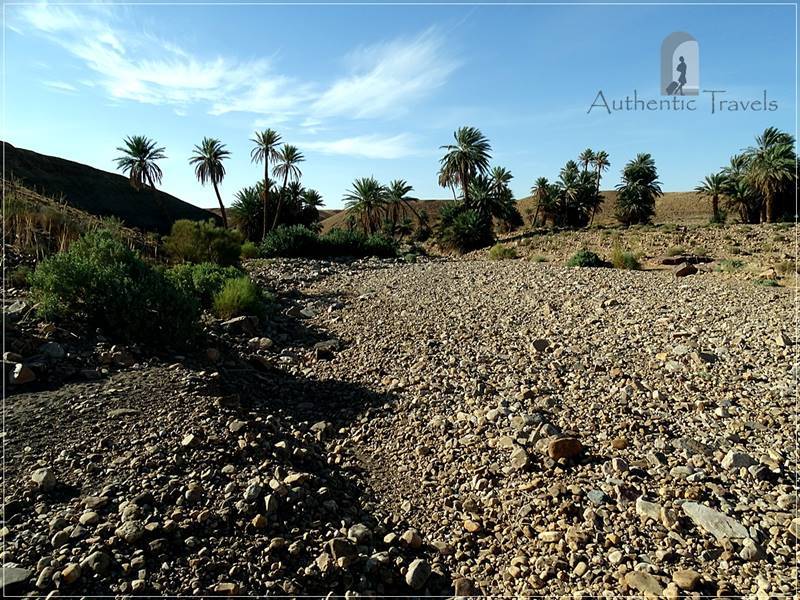
Camel Desert Trek – Day 2: the oasis in Tighrghrin where we should have spent the first night if I had been in a good shape the day before
We passed the Tighrghrin Oasis and descended toward the riverbed of the Ouad Mhasser Valley. After a long hot summer, the river was almost dried, but the camels found a few water ponds to drink. A mixed terrain dominated the scenery with stones and rocky boulders. The gentle ridges of some small mountains flanked the valley. Lonely palm trees and bushes appeared here and there on the valley’s riverbed. From time to time, we could see a phosphorescent orange point painted on stones. It was the sign for the Marathon des Sables route which took place in that area, Mohamed said to me.
The Ouad Mhasser was a wide valley with a rough, rocky riverbed. The footpath followed the edge of the valley and continued parallel to the riverbed we saw only a few meters below. In the narrower places, where camels passed with difficulty, I had to descend, let the camels pass over those sections, and then I climbed back on top of the camel. The saddle was hard and rather inconvenient to ride for longer periods, but as my dream would last for only four days, I stuck to it no matter what.
For a few hours, we walked almost continuously along the meandering Ouad Mhasser Valley. If I had given up riding the camel, I would have remained behind taking photos or for a rest. Therefore, even though the riding wasn’t comfortable, it was a sacred thing for me. Around noon, we reached the camp of a nomad family, placed near an oasis called Afrokh. The nomads’ goats grazed around the camp and climbed on all of the surrounding rocks. In the camp, a woman with many children around her (including a baby held on her back) warmly greeted us. We took a long break and served Moroccan tea boiled on embers, shriveled figs from the nearby oasis, fresh goat milk and butter, and warm bread just baked in the nearby earth oven.
Nomads lived in the high mountains during torrid summers and descended to the desert areas only from fall to spring. They chose a place for their camp near an oasis with a permanent source of water. Everything around the camp was green and therefore, their goats and camels had where to find something to eat. Nomads bought their primary food from the nearest settlement, where they went by camels or donkeys.
The nomads’ camp had only a few huts made of boulder masonry and covered with dry acacia branches. They also had a large Berber tent filled up with lots of stuff. The huts were placed under a tree that ensured a welcoming extra shade. One of the huts was the so-called kitchen. It differed from the rest of the other huts by having an earth oven built directly on the ground.
The nomads’ lifestyle had a distinctive uniqueness. Due to its harshness, it couldn’t exist without the balance between the acceptance of local conditions and the perseverance of its temporary residents. The nomads’ lifestyle adapted to the harsh conditions of the place and outlined some characteristics featuring a unique identity: toughness, perseverance, and acceptance.
I entered the so-called ‘kitchen’ to see how they baked bread. A little girl sat squatted and intensely stared at the embers inside of an earth oven. The loaves were some round pieces of dough already prepared, covered with a cloth. The girl extracted them from the cloth with two sticks and rapidly placed them in the oven on a metal counter-top. She handled them with remarkable speed. Then she turned each loaf on both sides and quickly slammed it into another cloth. Eventually, the steaming bread was ready to be served. It was hard to leave the nomad camp after having such a treatment, but we still had a long way to go to reach the golden dunes until dusk.
As we sat down for a break and chatted in the nomads’ camp, Lahssen and the camels who had remained behind us had just passed. We followed the same direction as they did and walked on a route winding through an infinite, flat immensity, full of large reddish boulders. After the Ouad Mhasser Valley left behind the mountains’ strait, we marched a few kilometers to find Lahssen cooking for us under a tree. We sat down to eat, then left behind the Jbel Bani Mountains and continued toward the Erg Chigaga Dunes.
The rocky terrain imperceptibly got sandy. The camels sunk into the sand. Thus we had to guide them to walk in between the dunes to diminish their efforts. Green bushes and shrubs disclosed the presence of a water source. We arrived at a concrete well where we refilled the canisters with supplies for cooking water, then we set up our camp somewhere in a small depression between the dunes of the Erg Chigaga chain. For dinner, we served a very-spicy Berber omelet and the traditional Moroccan vegetable soup, harira.
The third day of the camel desert trek
Short Description. We hiked on top of the highest dune in Morocco, Erg Chigaga (300-400 m) at dawn. During the day, we rode the camels and followed a route parallel to the chain of dunes. In the evening, we stopped near another group of dunes, Bogarne, where we camped for our last evening in the desert.
Lond Description.
At dawn, I climbed with Mohamed on top of the highest dune in Morocco – the famous Erg Chigaga. The dunes had a golden color of velvet appearance, full of countless ripples. My dream of walking on dunes had become true. With perseverance, availability to adapt to the local conditions, and acceptance of everything that had been offered to me – just like the nomads.
From the 300-meter height of Erg Chigaga, you could see the whole chain of dunes spanning over 40 kilometers. Early in the morning, the sand ridges were untouched and only the wind left gentle traces on the sand surface. You could see or hear small semi-permanent camps in the area, hidden among the dunes. Even a small hospital stood in the vicinity. An American doctor opened it in a precariously built enclosure to help tourists in case of need.
When we got back to the camp, our camels were ready to go. We went parallel to the chain of dunes and headed toward another chain of dunes, called Bogarne. The terrain was the same infinite flat field, stretching between mountains and dunes. Hiking the dunes would have been difficult both for us and the camels. Therefore, we preferred the hard and rocky terrain, easier to cross, but monotonous and tiresome.
We rode the camels until noon when we stopped for lunch in the shade of a tree in Oued Laatche. It was hot. As soon as we stopped, all the flies started to buzz us. Other small caravans stopped for lunch under other trees in the area. We had rice with lentils and pomegranate, then waited for the heatwave to pass. Some wild donkeys roared around and happily enjoyed our food leftovers.
In the afternoon, we reached the group of dunes in Bogarne. We set up our camp at the foot of the dunes just before dusk. I hiked alone to the top of the sands. The time passage seemed endless while sitting on the frail ridge of the dunes. A bit later, the sunset brought a fog that settled quietly, like a velvet, over the graceful dunes. A surreal peace and an unwavering silence reigned over the place, a feeling impossible to describe in words.
Our small camp shrouded by dunes became alive in the evening, and we again had harira soup and lamb tajine for dinner. Then we had the surprise of the evening: bread baked by Lahssen directly into the hot sand, a custom practiced in the desert when they didn’t have an oven. The flat dough was covered with hot sand and ember from an extinguished fire, and thus the high temperatures baked the dough in a few minutes.
The fourth day of the camel desert trek
Short Description. We left the Bogarne Dunes and set off on a flat, endless route. After lunch, a Berber wearing a long turban rescued us with a jeep from Ouad Naeme. He gave us a ride to M’Hamid border town, where we stayed overnight in a camping ground with mudbrick huts.
Long Description.
It was our last day in the desert. I somehow regretted I had to leave the desert and its unique lifestyle. At the same time, I was glad I would finally have a shower. From the Bogarne Dunes, we went South, while the temperatures got higher and higher. We refilled our canisters with fresh water at the only well we passed by in four hours. Each camel got two additional canisters full of water to carry. We gradually left behind the dunes, and the terrain became flat, rocky, just a straight line on the horizon.
The camels walked sluggishly but had a constant walking pace. At noon, the sun shone right above our heads. The heat was unbearable, and nothing was good enough: the effort to walk was too big, while if I had ridden a camel, the sun would have burned me too much. Eventually, we reached Ouad Naeme, a flat area with rocks, small dunes, and a few trees. Nothing else. A herd of hundreds of wild camels crossed at the horizon, while a sandstorm was about to start out of the blue. We quickly ate a vegetable salad adorned with oranges and sheltered ourselves from the sandstorm while we were waiting for a jeep to come from M’Hamid.
We waited for the jeep for quite a while. We were located on one of the numberless roads intersecting each other in the desert. Without real landmarks – just in the shade of an acacia tree, like many others at the horizon. The technical gadgets were not very precise in the desert. Nevertheless, after a few hours of waiting, a young man wearing a long turban wrapped around his head appeared from a cloud of sand and greeted us as he got off a dilapidated jeep.
We quickly loaded our luggage in the jeep and released the camels from the heavy burden. Lahssen would walk with the camels for another 10 kilometers, while we would go by jeep to the border town of M’Hamid Lghzlan. We spent the night in a camping ground with a restaurant set up in a Berber tent and earth huts scattered amidst tall palm trees. The showers were the blessing of the evening, although the water was cold. Equally, the last tajine with vegetables and chicken was a blessing too after a long walking day.
A part of the desert experience’s intensity disappeared when I re-entered the civilized world. But the profoundness of the feelings and the strong imprint left by the memories of the desert remained. Even though it was a tough experience, such an adventure was full of meaningful lessons, which I accepted as such and integrated into my life. I reconnected with my Self and lived what this adventure brought me – a tough experience from which, however, I re-became myself.
The Camel Desert Trek – Zagora to M’Hammid is the travel journal about the camel trek through a small part of the Sahara Desert in Morocco. Many thanks to Tizi Trekking for the invitation to this press trip through a part of the Sahara desert. If you want to read more about the road trip through Morocco, here are all the Travelogues from Morocco (x21).
Have you been to Morocco or plan to go there? Leave a comment below this post and tell me what you liked in Morocco or what you want to see there.
Want to subscribe to my travelogues? Just leave your email in the subscription form below, and you’ll be notified when I publish a new post.
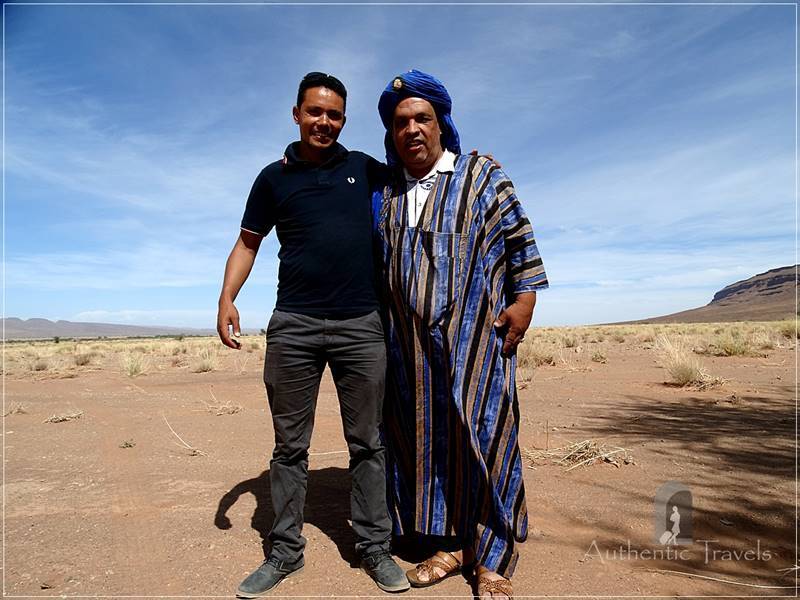
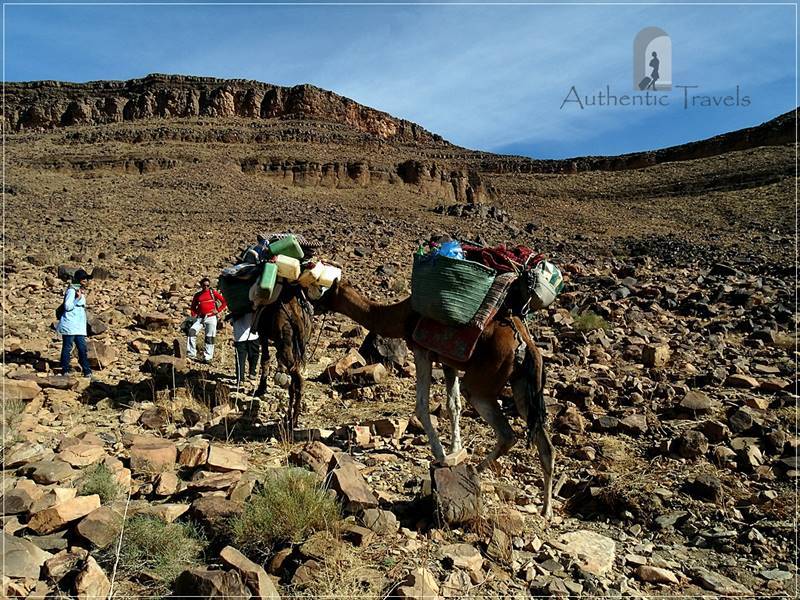
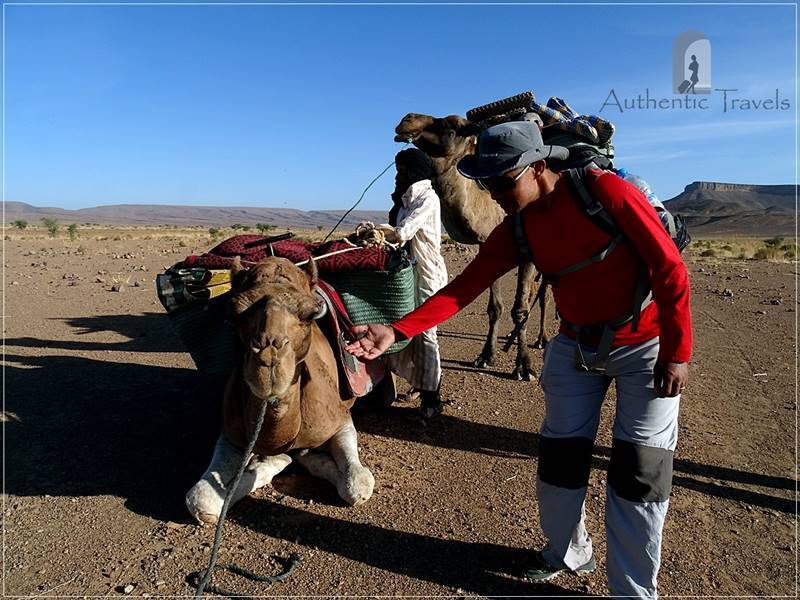
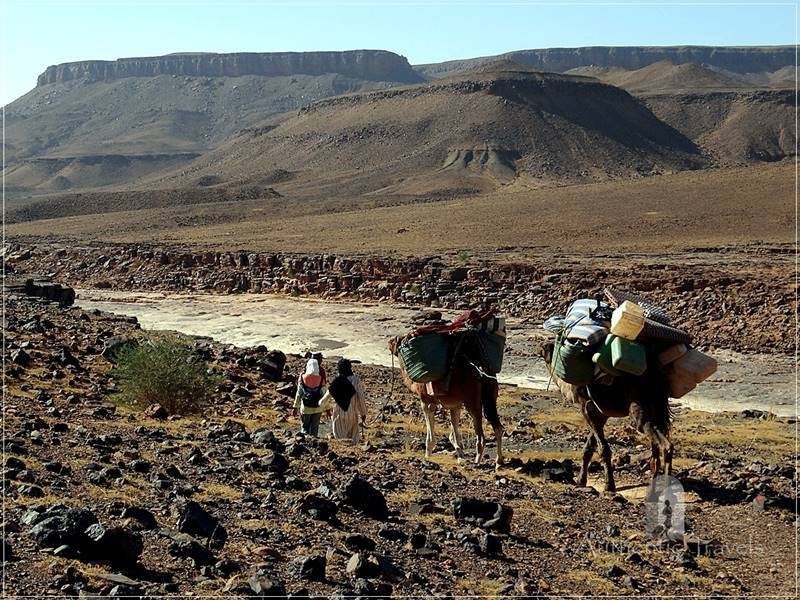
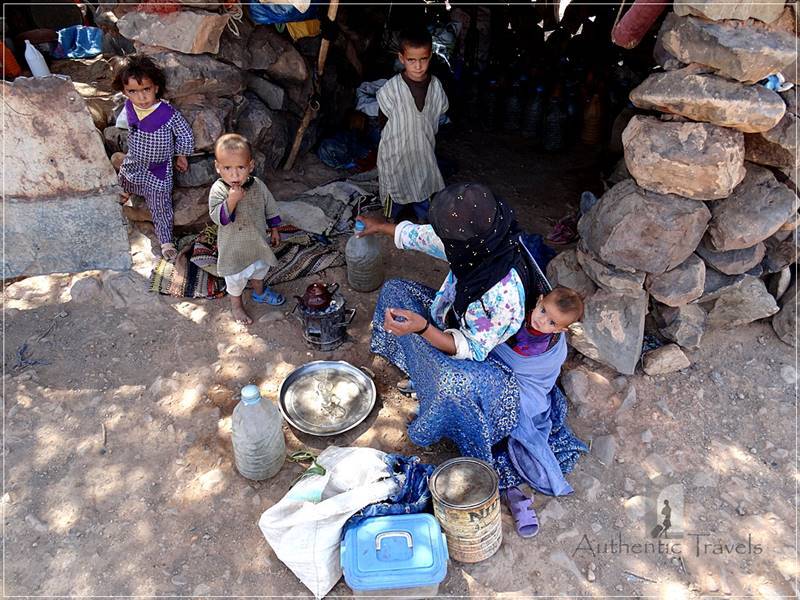
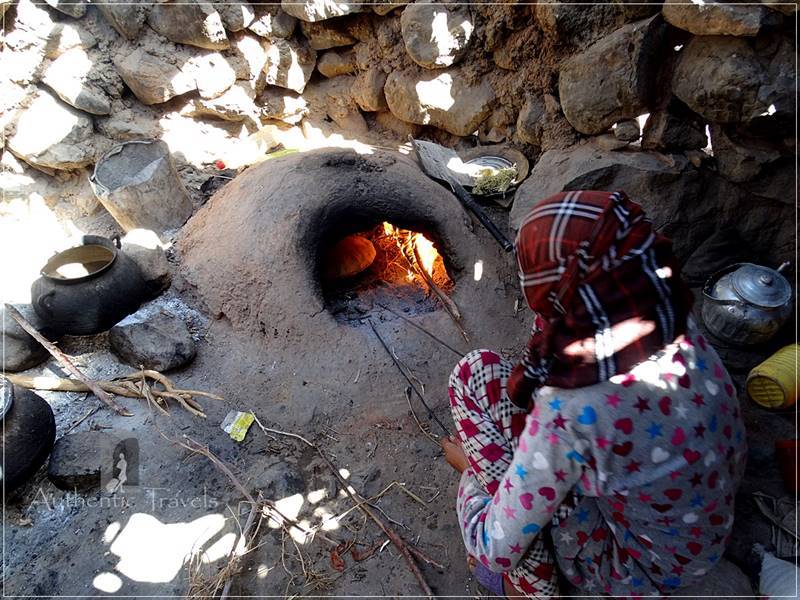
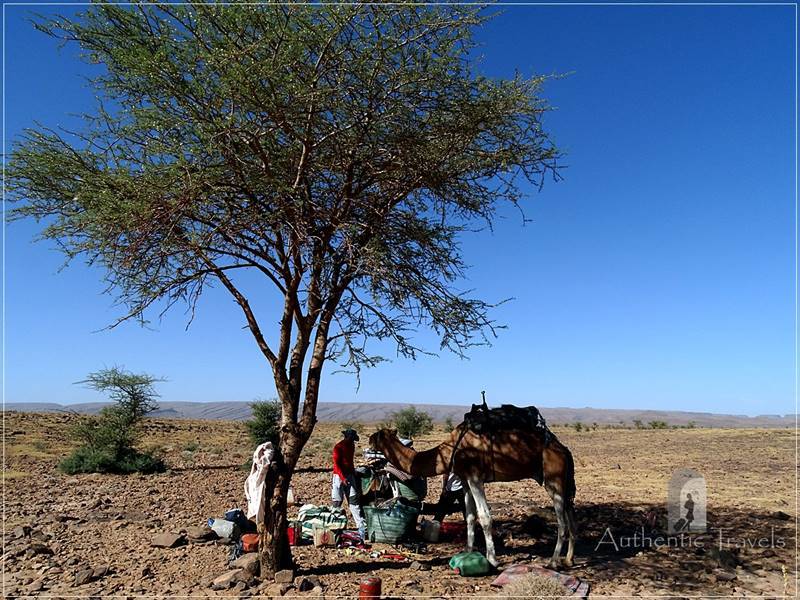
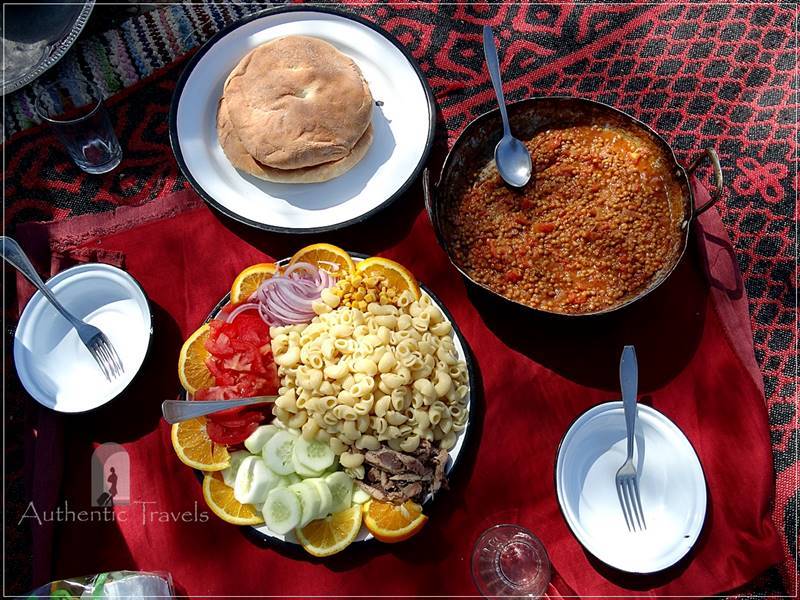
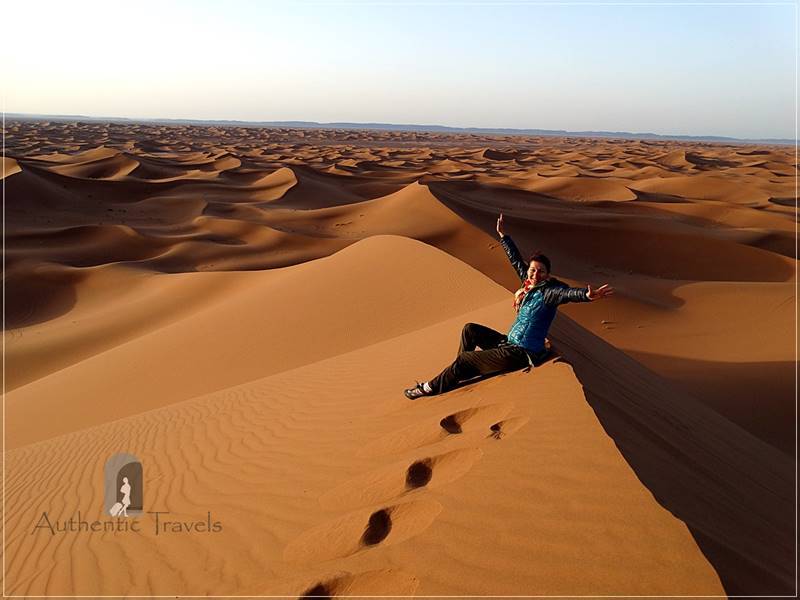
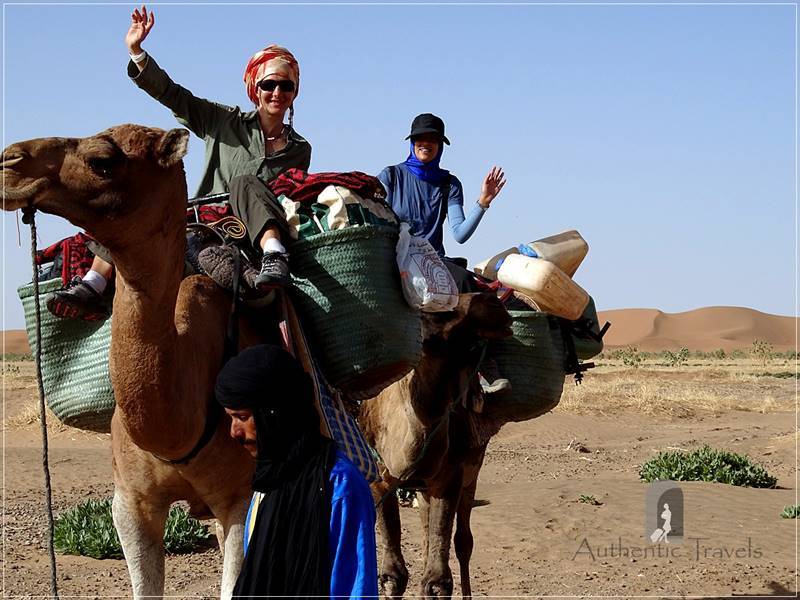
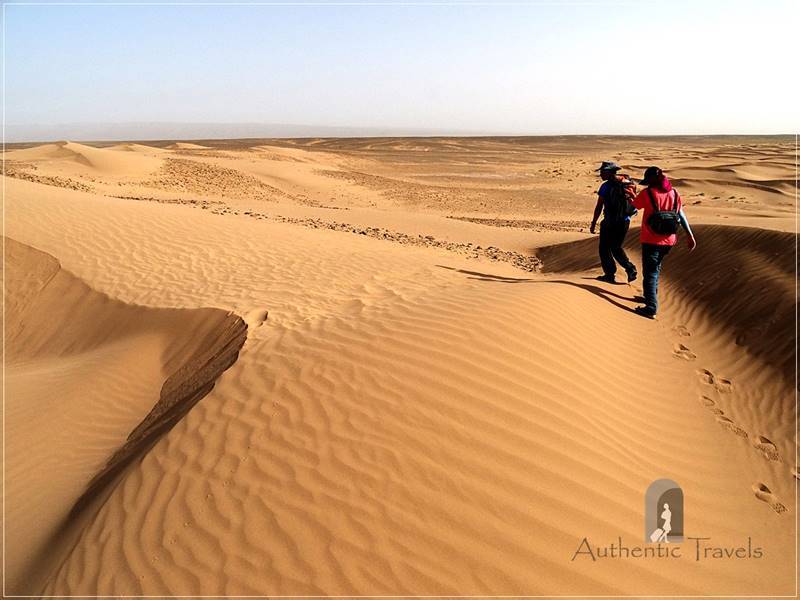
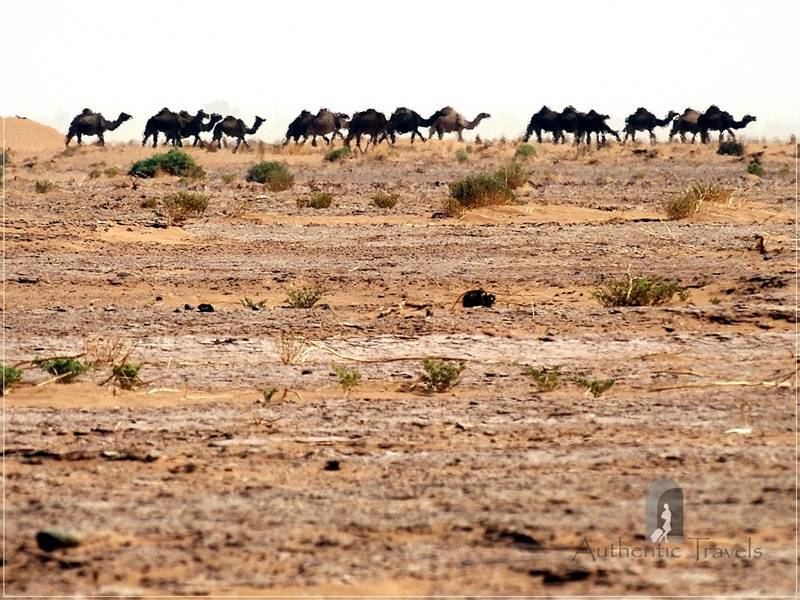
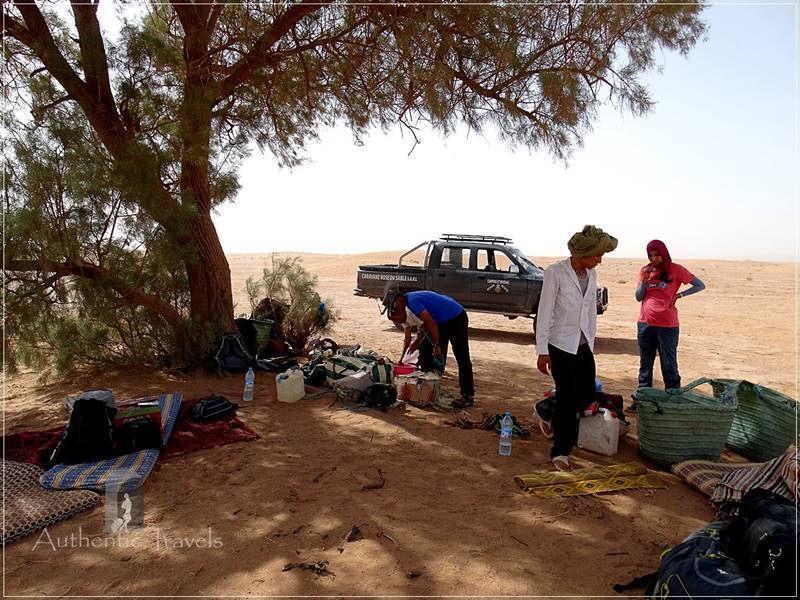
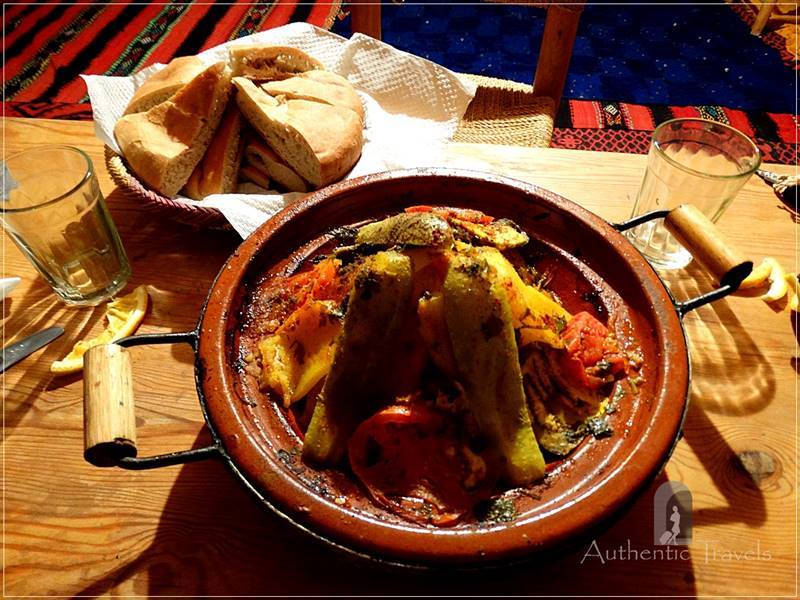
Very nice article – when reading it, I almost felt being there !
I am so happy to hear that!
Wow, what an experience and look into somebody else’s life. Seeing how desert people live is such a contract to us in cities. So cool to share this. Thank you.
It was fascinating to see that small nomad camp. They were real, not for touristic purpose.
What a nice experience! It must have been so interesting to see that nomad camp!
The Nomad camp was the best of all 🙂 In many desert safaris you see them there just for tourist purpose, but these ones were real, I’ve seen the ‘house’ with everything 🙂
Very nice article – when reading it I almost felt like being there !
Spectacular! My family did a very short camel ride in Wadi Rum, Jordan and loved every second. It looks like the views and food on your trip were amazing!
I strongly recommend a longer trip into the desert. You have time to see things in a different way than in a short trip.
What an amazing experience! I would love to do this someday! Is there a cooler time of year to do it?
In winter. October/November to April/May. But when I was there at the beginning of October it was very hot (40 C). So that’s why I recommend real winter time 🙂
What an amazing trek and great experience. The desert has a wild beauty which is so appealing. Great post.
Thank you. I always recommend a trek in the desert for an authentic experience.
This brings back so many memories, as I also had an experience like yours, Their way of living is beyond interesting and beautiful!
It’s fascinating to always find new ways to discover remoter and authentic places. This lifestyle they have in the desert is absolutely stunning, … at least for me.
I have always wanted to visit Morocco and have been really trying to get there sooner than later. When we do go Erg Chigaga is a must! You have amazing photos from your sunrise there. What a beautiful and unforgettable experience!
Camels and sand dunes are my favorite. That’s where I fell authentic. And the guide was terrific – he knew every single spot of the trail.
What a cool experience! I went on a camel when I was in Morocco in December, but we just trekked out to a camp and spent the night there and then came back. I loved it but it’s cool that you got to go for longer. And I completely agree that the Moroccan nomad way of life is very interesting.
Hopping from one camp to another is even more challenging as you immerse yourself pretty much in the desert and you’re away of all the ‘civilization’ out there.
Wow! This is quite the adventure. I love the photos and I also always love looking at food photos. I bet it felt really nice to finally get in that shower!
A trek in remoter areas is always a way to immerse yourself in a different lifestyle.